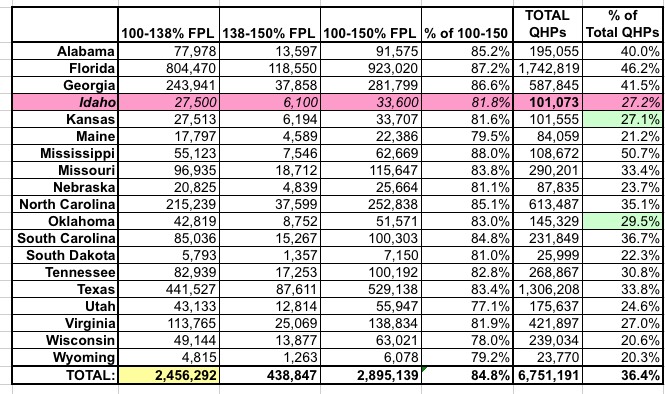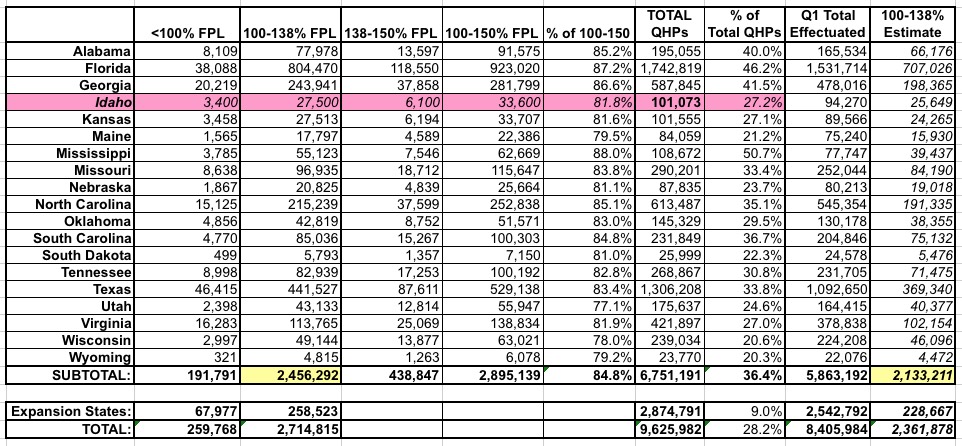UPDATE: Up to 2.1 million Exchange enrollees SHOULD be eligible for Medicaid instead...

Almost exactly 1 year ago, both Andrew Sprung and I realized that due to an overlap in two provisions of the ACA, a significant chunk of exchange enrollees would actually be eligible for Medicaid instead of a private QHP...if the remaining Republican holdout states were to stop being jackasses and expand the program already.
Why? Because while ACA Medicaid expansion covers people up to 138% of the Federal Poverty Line, QHP financial assistance applies to those with incomes between 100-400% of the FPL. In other words, anyone enrolled in a private exchange policy between 100-138% FPL in a NON-expansion state would automatically become eligible for Medicaid instead the moment that state expanded their Medicaid program via the ACA.
Unfortunately, there was no way of knowing exactly how many people this applied to, because until now, the HHS Dept. only broke out exchange enrollee income brackets into 50% chunks (ie, they listed 100-150% FPL, but not 100-138%).
Andrew and I both took a crack at estimating the 100-138% bracket, and came up with several different numbers; I figured around 1.9 million, while Sprung initially agreed with my 1.9 million figure but later revised his estimate to just 1.6 million. Meanwhile, Richard Mayhew at Balloon Juice chimed in to say he thought it was higher than 1.9 million.
Of course, a few things have happened since last summer. For one thing, both Alaska and Louisiana have expanded Medicaid via the ACA, dropping the number of non-expansion states from 21 to 19. For another, those estimates were all based on the 2015 enrollment numbers (11.7 million nationally); 2016 bumped this up by another million people, although the relative increases vary by state.
THANKFULLY, just today, the CMS division of HHS released a highly-detailed 2016 QHP selection report (for the 38 HC.gov states only)...which, for the first time, breaks out income levels into the 100-138% FPL range!
In all, 2,687,315 people within the 100-138% range selected QHPs via HC.gov this year. 18 of the 19 non-expansion states are included, because Idaho runs their own full exchange. Subtracting out the states which did expand Medicaid leaves us with the following (I'll explain my estimate for Idaho below):

Exactly 101,073 people selected QHPs during OE3 in Idaho. This is almost identical to the number who enrolled in Kansas. I don't know whether economic demographics are similar between these two states, but assuming they are, the 100-138% level should be pretty close as well, The other 18 states are all hard numbers from the CMS/ASPE reports for this year.
This shows that nearly 2.5 million people in non-expansion states fall into the 100-138% category.
Interestingly, as Sprung just pointed out to me, this means that there's also another 258,000 people in that income range in expansion states who are enrolled in exchange policies...presumably made up of legal noncitizens and other special categories.
HOWEVER, there's one more step we need to take: How many were actually enrolled in effectuated policies as of the end of March?
When you plug those numbers into the spreadsheet, you get slightly lower numbers...assuming that there's an even spread among those who failed to pay/dropped out between January and March (which obviously may not be the case):

There you have it. As of March 31st, 2016, roughly 2.1 million people who were enrolled in ACA exchange-based private policies would instead be eligible for Medicaid if the 19 states above were to expand the program.
This represents around 19% of all current exchange enrollees.
UPDATE: OK, a couple of addtiional notes, as pointed out to me by Sprung:
- As noted above, there's also around 258,000 people in the 100-138% FPL range in expansion states enrolled in private plans instead of Medicaid...but they only make up 9% of the total in those states, vs. 36.4% in the non-expansion states. Assuming this ratio would be similar if the remaining 19 states did cave, that would probably mean that only around 1.6 million of these folks would be shifted over to Medicaid instead of all 2.1 million
- Also noteworthy: Around 260,000 exchange enrollees are below 100% of FPL, which may sound strange since that's below the APTC cut-off...except for legally-present non-citizens, who are eligible for APTC but aren't eligible for Medicaid, which is kind of interesting and ironic, especially given the "Medicaid Gap" situation.
- Again, remember that none of this includes the 13 state-based exchanges, 12 of which are in expansion states anyway which makes them irrelevant for most of this entry.
I've expanded the spreadsheet even further to include the additional data:

UPDATE x2: As Josh Schultz pointed out, at least a portion of the 2.1M might be due to the fact that some Medicaid-eligible exchange enrollees were also enrolled in private QHPs as well as Medicaid by mistake, due to lingering technical bugs in the "no wrong door" system. Neither he nor I know how many people this might apply to, however. For this and the other reasons noted above, I'm changing this to "up to" 2.1 million.



